AgileScrumGuide.com Review of 15 Agile Project Management Tools
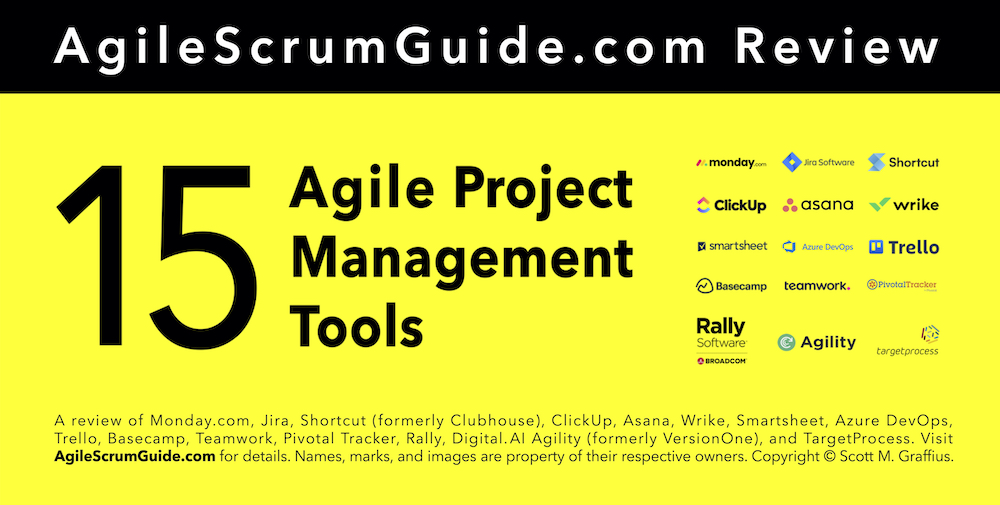

Introduction
Projects are the vehicles and project management is the engine for organizational success. Strategic objectives and other initiatives are fulfilled by projects — endeavors undertaken to create a unique product, service, or result. The art and science of project management — the application of knowledge, skills, tools, and techniques to projects — is indispensable for the management and completion of projects.
Tools can make a significant contribution to the success of projects. This report provides a unique high standard, side-by-side review of 15 Agile project management tools. Those interested in selecting a related product can leverage the information presented here to assist in their decision-making.
Now, on to the review!



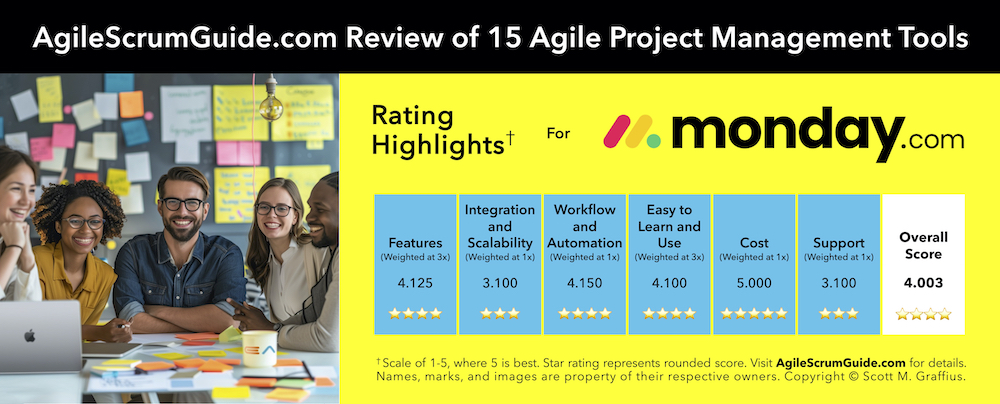
#1
Monday(dot)com
Overall Score (on a scale of 1-5, where 5 is best): 4.003
- Features: 4.125
- Integration and Scalability: 3.100
- Workflow and Automation: 4.150
- Easy to Use and Understand: 4.100
- Cost: 5.000
- Support: 3.100
Additional Information
- Abridged product description or slogan from company: "The #1 Work Management Platform For All Teams"
- Company: Monday(dot)com
- Headquarters: Tel Aviv-Yafo, Israel
- Website: https://monday.com
- 𝐗 (formerly Twitter): @mondaydotcom - https://twitter.com/mondaydotcom
Also see the FAQs section of this article.

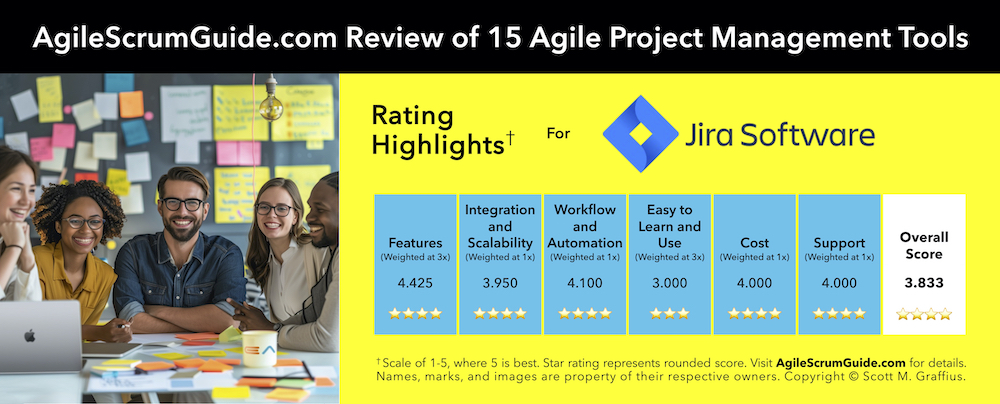
#2
Jira
Overall Score (on a scale of 1-5, where 5 is best): 3.833
- Features: 4.425
- Integration and Scalability: 3.950
- Workflow and Automation: 4.100
- Easy to Use and Understand: 3.000
- Cost: 4.000
- Support: 4.000
Additional Information
- Abridged product description or slogan from company: "Move fast, stay aligned, and build better - together"
- Company: Atlassian
- Headquarters: Sydney, Australia
- Website: https://www.atlassian.com
- 𝐗 (formerly Twitter): @Jira - https://twitter.com/Jira
Also see the FAQs section of this article.

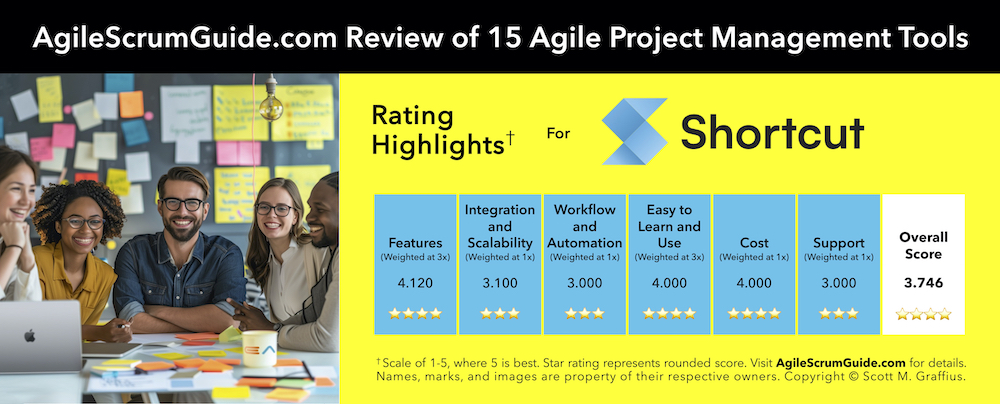
#3
Shortcut (formerly Clubhouse)
Overall Score (on a scale of 1-5, where 5 is best): 3.746
- Features: 4.120
- Integration and Scalability: 3.100
- Workflow and Automation: 3.000
- Easy to Use and Understand: 4.000
- Cost: 4.000
- Support: 3.000
Additional Information
- Abridged product description or slogan from company: "Shortcut aligns product development work with company objectives so teams can execute with a shared purpose"
- Company: Shortcut Software Company
- Headquarters: New York City, New York, United States
- Website: https://www.shortcut.com
- 𝐗 (formerly Twitter): @shortcut - https://twitter.com/shortcut
Also see the FAQs section of this article.


#4
ClickUp
Overall Score (on a scale of 1-5, where 5 is best): 3.703
- Features: 4.125
- Integration and Scalability: 3.350
- Workflow and Automation: 4.000
- Easy to Use and Understand: 3.100
- Cost: 5.000
- Support: 3.000
Additional Information
- Abridged product description or slogan from company: "Get everyone working in a single platform designed to manage any type of work"
- Company: Mango Technologies, Inc.
- Headquarters: San Diego, California, United States
- Website: https://clickup.com
- 𝐗 (formerly Twitter): @clickup - https://twitter.com/clickup
Also see the FAQs section of this article.

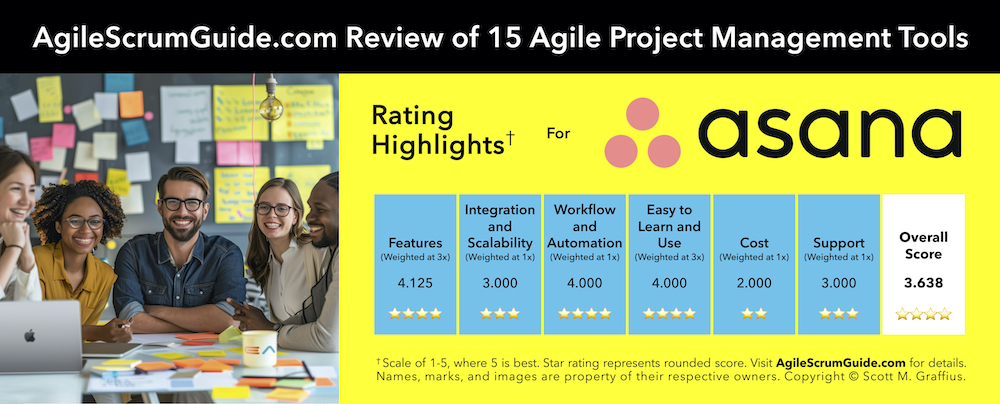
#5
Asana
Overall Score (on a scale of 1-5, where 5 is best): 3.638
- Features: 4.125
- Integration and Scalability: 3.000
- Workflow and Automation: 4.000
- Easy to Use and Understand: 4.000
- Cost: 2.000
- Support: 3.000
Additional Information
- Abridged product description or slogan from company: "Make it easier for your team to do more work that matters"
- Company: Asana, Inc.
- Headquarters: San Francisco, California, United States
- Website: https://asana.com
- 𝐗 (formerly Twitter): @asana - https://twitter.com/asana
Also see the FAQs section of this article.


#6
Wrike
Overall Score (on a scale of 1-5, where 5 is best): 3.516
- Features: 3.720
- Integration and Scalability: 3.000
- Workflow and Automation: 4.000
- Easy to Use and Understand: 3.000
- Cost: 5.000
- Support: 3.000
Additional Information
- Abridged product description or slogan from company: "One platform to
- streamline all workflows"
- Company: Citrix Systems
- Headquarters: San Jose, California, United States
- Website: https://www.wrike.com
- 𝐗 (formerly Twitter): @wrike - https://twitter.com/wrike
Also see the FAQs section of this article.

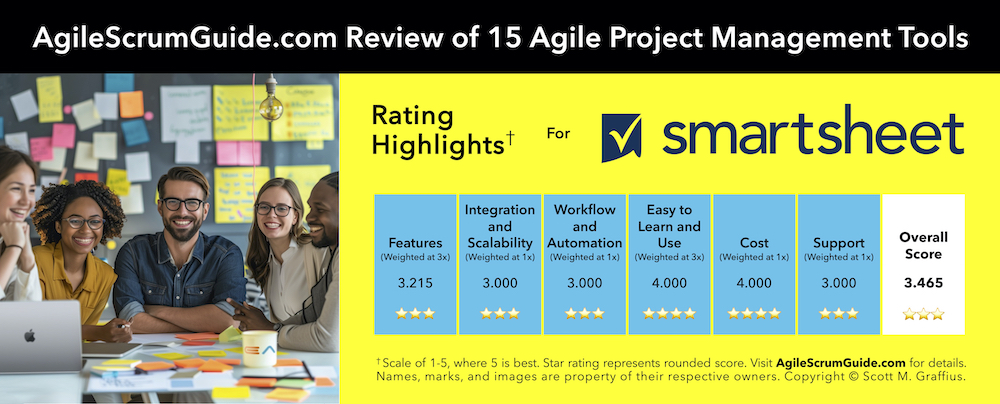
#7
Smartsheet
Overall Score (on a scale of 1-5, where 5 is best): 3.465
- Features: 3.215
- Integration and Scalability: 3.000
- Workflow and Automation: 3.000
- Easy to Use and Understand: 4.000
- Cost: 4.000
- Support: 3.000
Additional Information
- Abridged product description or slogan from company: "The enterprise work management platform"
- Company: Smartsheet, Inc.
- Headquarters: Bellevue, Washington, United States
- Website: https://www.smartsheet.com
- 𝐗 (formerly Twitter): @Smartsheet - https://twitter.com/smartsheet
Also see the FAQs section of this article.

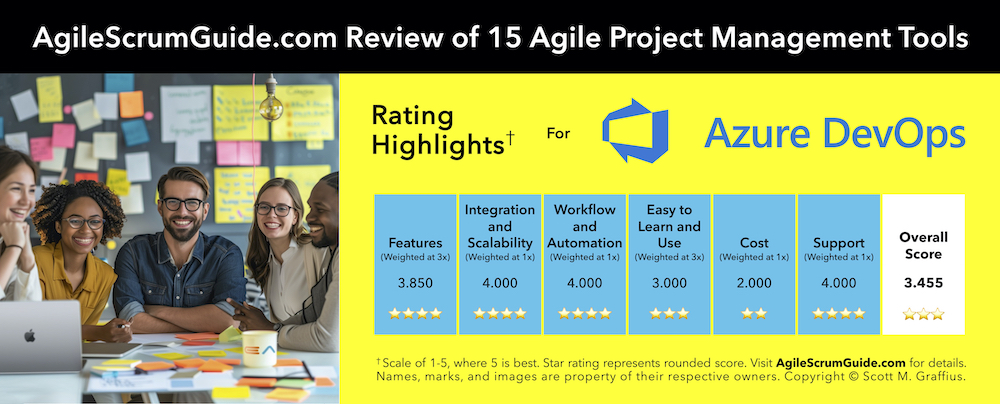
#8
Azure DevOps
Overall Score (on a scale of 1-5, where 5 is best): 3.455
- Features: 3.850
- Integration and Scalability: 4.000
- Workflow and Automation: 4.000
- Easy to Use and Understand: 3.000
- Cost: 2.000
- Support: 4.000
Additional Information
- Abridged product description or slogan from company: "Plan smarter, collaborate better, and ship faster with a set of modern dev services"
- Company: Microsoft
- Headquarters: Redmond, Washington, United States
- Website: https://azure.microsoft.com/en-us/products/devops
- 𝐗 (formerly Twitter): @Azure - https://twitter.com/azure
Also see the FAQs section of this article.

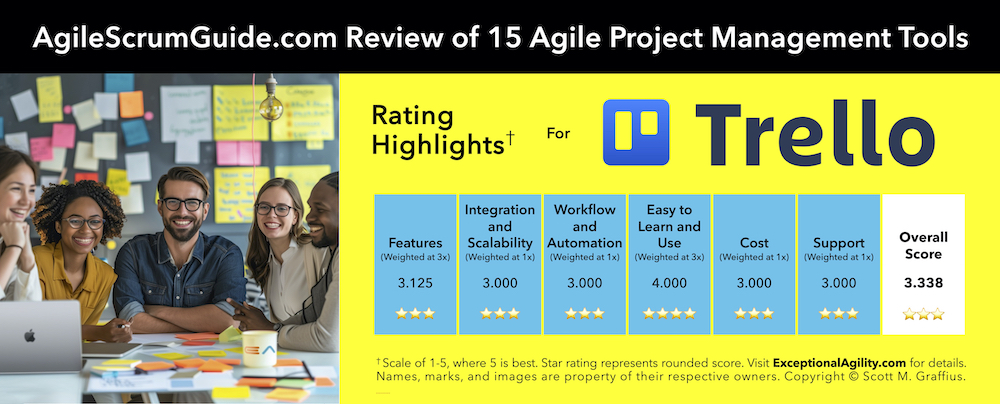
#9
Trello
Overall Score (on a scale of 1-5, where 5 is best): 3.338
- Features: 3.125
- Integration and Scalability: 3.000
- Workflow and Automation: 3.000
- Easy to Use and Understand: 4.000
- Cost: 3.000
- Support: 3.000
Additional Information
- Abridged product description or slogan from company: "Trello brings all your tasks, teammates, and tools together"
- Company: Atlassian
- Headquarters: Sydney, Australia
- Website: https://trello.com
- 𝐗 (formerly Twitter): @trello - https://twitter.com/trello
Also see the FAQs section of this article.

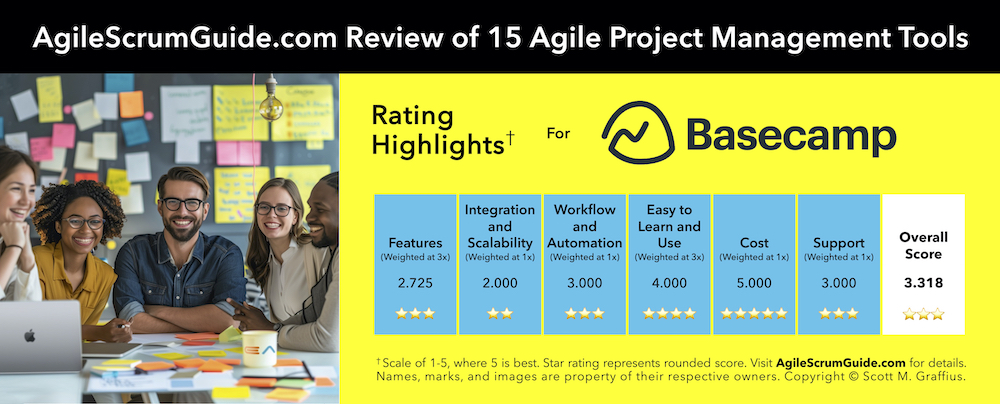
#10
Basecamp
Overall Score (on a scale of 1-5, where 5 is best): 3.318
- Features: 2.725
- Integration and Scalability: 2.000
- Workflow and Automation: 3.000
- Easy to Use and Understand: 4.000
- Cost: 5.000
- Support: 3.000
Additional Information
- Abridged product description or slogan from company: "Basecamp’s the project management platform that helps small teams move faster and make more progress than they ever thought possible"
- Company: 37signals
- Headquarters: Chicago, Illinois, United States
- Website: https://basecamp.com
- 𝐗 (formerly Twitter): @basecamp - https://twitter.com/basecamp
Also see the FAQs section of this article.

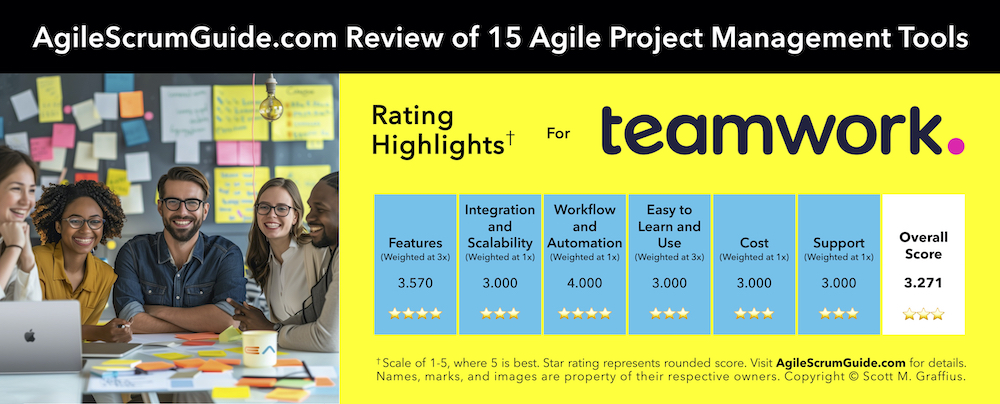
#11
Teamwork
Overall Score (on a scale of 1-5, where 5 is best): 3.271
- Features: 3.570
- Integration and Scalability: 3.000
- Workflow and Automation: 4.000
- Easy to Use and Understand: 3.000
- Cost: 3.000
- Support: 3.000
Additional Information
- Abridged product description or slogan from company: "The all-in-one team platform to manage every aspect of your client work"
- Company: Teamwork(dot)com Ltd
- Headquarters: Blackpool, Cork, Ireland
- Website: https://www.teamwork.com
- 𝐗 (formerly Twitter): @teamwork - https://twitter.com/teamwork
Also see the FAQs section of this article.

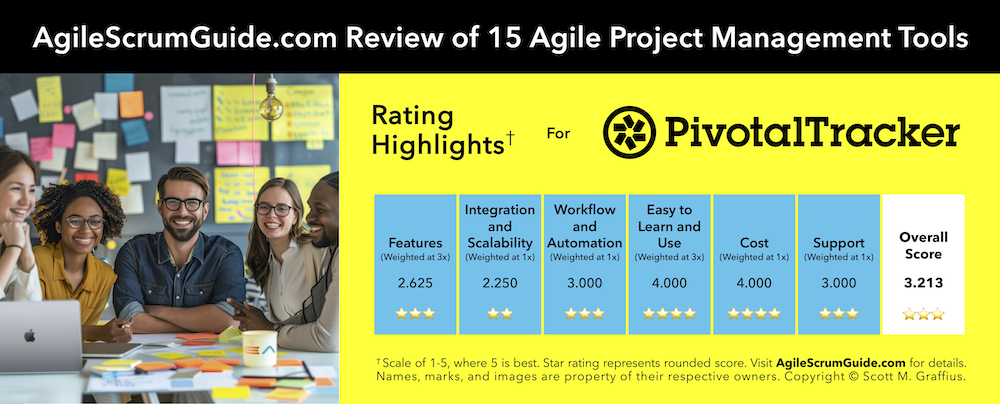
#12
Pivotal Tracker
Overall Score (on a scale of 1-5, where 5 is best): 3.213
- Features: 2.625
- Integration and Scalability: 2.250
- Workflow and Automation: 3.000
- Easy to Use and Understand: 4.000
- Cost: 4.000
- Support: 3.000
Additional Information
- Abridged product description or slogan from company: "Proven project management for successful teams"
- Company: VMware
- Headquarters: San Francisco, California, United States
- Website: https://www.pivotaltracker.com
- 𝐗 (formerly Twitter): @pivotaltracker - https://twitter.com/pivotaltracker
Also see the FAQs section of this article.

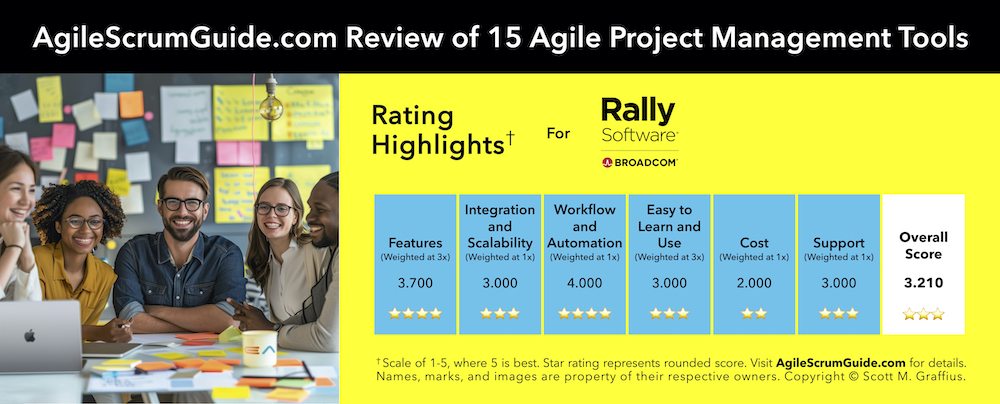
#13
Rally
Overall Score (on a scale of 1-5, where 5 is best): 3.210
- Features: 3.700
- Integration and Scalability: 3.000
- Workflow and Automation: 4.000
- Easy to Use and Understand: 3.000
- Cost: 2.000
- Support: 3.000
Additional Information
- Abridged product description or slogan from company: "Rally is purpose built for enterprise agility at scale"
- Company: Broadcom
- Headquarters: San Jose, California, United States
- Website: https://www.broadcom.com/products/software/value-stream-management/rally
- 𝐗 (formerly Twitter): @Broadcom - https://twitter.com/Broadcom
Also see the FAQs section of this article.

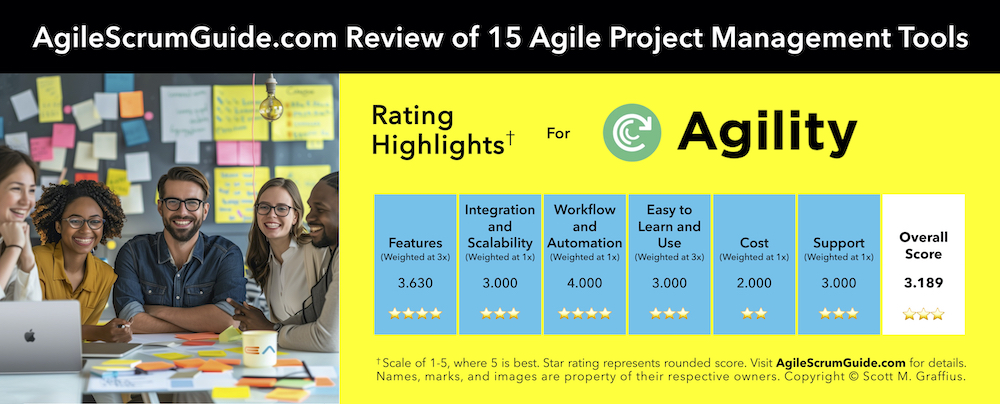
#14
Digital(dot)AI Agility (formerly VersionOne)
Overall Score (on a scale of 1-5, where 5 is best): 3.189
- Features: 3.630
- Integration and Scalability: 3.000
- Workflow and Automation: 4.000
- Easy to Use and Understand: 3.000
- Cost: 2.000
- Support: 3.000
Additional Information
- Abridged product description or slogan from company: "Digital.ai Agility is the industry-leading enterprise Agile planning solution driving efficiency by scaling Agile practices across all levels"
- Company: Digital(dot)AI Software, Inc.
- Headquarters: Raleigh, North Carolina, United States
- Website: https://digital.ai/products/agility/
- 𝐗 (formerly Twitter): @digitaldotai - https://twitter.com/digitaldotai
Also see the FAQs section of this article.


#15
Targetprocess
Overall Score (on a scale of 1-5, where 5 is best): 3.180
- Features: 3.600
- Integration and Scalability: 3.000
- Workflow and Automation: 4.000
- Easy to Use and Understand: 3.000
- Cost: 2.000
- Support: 3.000
Additional Information
- Abridged product description or slogan from company: "Enterprise Agile made easy"
- Company: Appito, an IBM Company
- Headquarters: Bellevue, Washington, United States
- Website: https://www.apptio.com/products/targetprocess/
- 𝐗 (formerly Twitter): @Apptio - https://twitter.com/Apptio
Also see the FAQs section of this article.


Conclusion

Tools can help advance the successful management and completion of projects. This report provided a unique multi-criteria, high standard, side-by-side review of 15 Agile project management tools. Those interested in selecting a related product can leverage the information to assist in their decision-making.



Frequently Asked Questions (FAQs)
Q: Did the assessment review free, paid, or both free and paid versions of the tools? A: The review assessed only paid versions of products in order to evaluate their complete set of features and full potential.
Q: What factors were assessed? A: The review assessed six factors: features (weighted at 3x), integration and scalability (weighted at 1x), workflow and automation (weighted at 1x), easy to learn and use (weighted at 3x), cost (weighted at 1x), and support (weighted at 1x).
Q: Why were two factors — features, and easy to learn and use — weighted more heavily in the assessment? A: Those two factors were prioritized by weighing each at 3x due to their fundamental role in user adoption and experience.
Q: What was the rating scale? A: The numerical scale was 1-5, with 5 being best. The report also included star ratings, which represented the respective rounded score. For example, a score of 3.833 rounded to 4, so 4 stars were shown in that case.
Q: Why did none of the tools receive the overall rating of five stars? A: The evaluation employed a rigorous set of criteria and had very high standards for what would constitute a five-star rating. As described earlier, the overall score was comprised of six factors. For those constituent factors, some products scored the maximum of 5.000, which translated to five stars. For the overall score, however, none of the tools received a score which would be equivalent to five stars. Monday(dot)com received the highest overall score; it was 4.003, which translated to four stars.
Q: Is there a qualitative analog (such as 'good' or 'great') in addition to the numerical scores and star ratings? A: Adapted from IGN's rating system, a supplemental scale for this review is delineated as: 'awful' 1.0 to 1.5, 'bad' 1.6 to 2.0, 'mediocre' 2.1 to 2.5, 'okay' 2.6 to 3.0, 'good' 3.1 to 3.5, 'great' 3.6 to 4.0, 'amazing' 4.1 to 4.5, and 'masterpiece' 4.6 to 5.0. The overall scores for tools in this review ranged from 3.180 to 4.003. Overlaying the overall scores on the supplemental scale, ten tools are 'good' and five tools are 'great.'


How to Cite This Article
Graffius, Scott M. (2024, February 26). AgileScrumGuide.com Review of 15 Agile Project Management Tools. Available at: https://agilescrumguide.com/blog/files/15-tools-2024.html. DOI: 10.13140/RG.2.2.16887.80800.



About Scott M. Graffius

Scott M. Graffius, PMP, SA, CSP-SM, CSP-PO, CSM, CSPO, ITIL, LSSGB is an agile project management practitioner, consultant, multi-award-winning author, and international keynote speaker. He is the Founder of Exceptional PPM and PMO Solutions™ and subsidiary Exceptional Agility™. He has generated over $1.9 billion of business value in aggregate for Global Fortune 500 businesses and other organizations he has served. Graffius and content from his books (Agile Scrum: Your Quick Start Guide with Step-by-Step Instructions and Agile Transformation: A Brief Story of How an Entertainment Company Developed New Capabilities and Unlocked Business Agility to Thrive in an Era of Rapid Change), talks, workshops, and more have been featured and used by businesses, professional associations, governments, and universities. Examples include Microsoft, Oracle, Broadcom, Cisco, Gartner, Project Management Institute, IEEE, Qantas, National Academy of Sciences, United States Department of Energy, New Zealand Ministry of Education, Yale University, Tufts University, and others. He has delighted audiences with dynamic and engaging talks and workshops on agile, project management, and technology leadership at 89 conferences and other events across 25 countries.
Connect with Scott on:

About Agile Scrum: Your Quick Start Guide with Step-by-Step Instructions
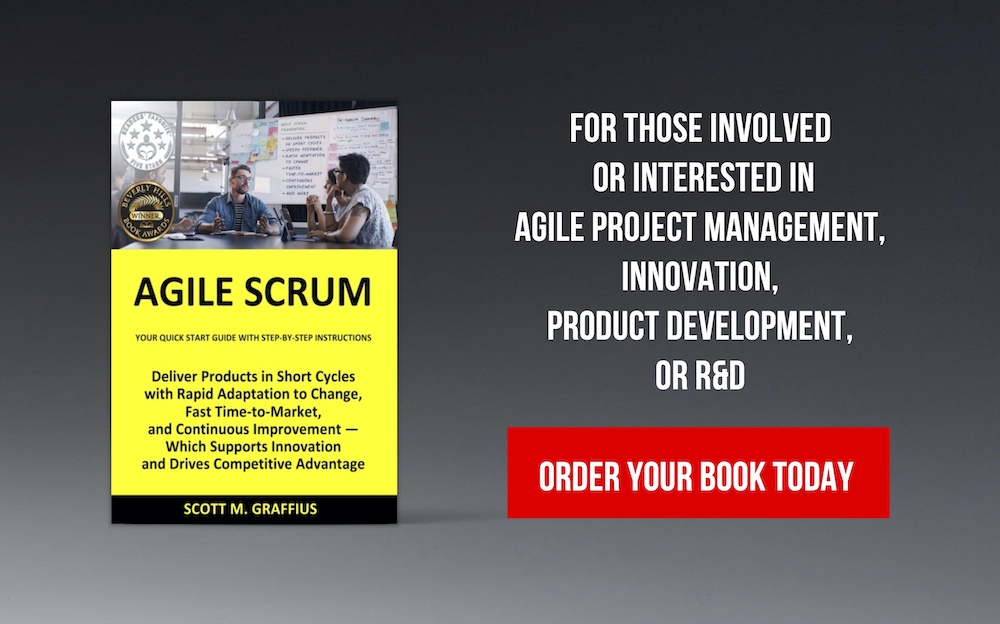
Shifting customer needs are common in today's marketplace. Businesses must be adaptive and responsive to change while delivering an exceptional customer experience to be competitive.
There are a variety of frameworks supporting the development of products and services, and most approaches fall into one of two broad categories: traditional or agile. Traditional practices such as waterfall engage sequential development, while agile involves iterative and incremental deliverables. Organizations are increasingly embracing agile to manage projects, and best meet their business needs of rapid response to change, fast delivery speed, and more.
With clear and easy to follow step-by-step instructions, Scott M. Graffius's award-winning Agile Scrum: Your Quick Start Guide with Step-by-Step Instructions helps the reader:
- Implement and use the most popular agile framework―Scrum;
- Deliver products in short cycles with rapid adaptation to change, fast time-to-market, and continuous improvement; and
- Support innovation and drive competitive advantage.
Hailed by Literary Titan as “the book highlights the versatility of Scrum beautifully.”
Winner of 17 first place awards.
Agile Scrum: Your Quick Start Guide with Step-by-Step Instructions is available in paperback and ebook/Kindle worldwide. Some links by country follow.
- 🇦🇺 Australia
- 🇦🇹 Austria
- 🇧🇪 Belgium
- 🇧🇷 Brazil
- 🇨🇦 Canada
- 🇨🇿 Czech Republic
- 🇩🇰 Denmark
- 🇫🇮 Finland
- 🇫🇷 France
- 🇩🇪 Germany
- 🇬🇷 Greece
- 🇭🇺 Hungary
- 🇮🇳 India
- 🇮🇪 Ireland
- 🇮🇱 Israel
- 🇮🇹 Italy
- 🇯🇵 Japan
- 🇱🇺 Luxembourg
- 🇲🇽 Mexico
- 🇳🇱 Netherlands
- 🇳🇿 New Zealand
- 🇳🇴 Norway
- 🇪🇸 Spain
- 🇸🇪 Sweden
- 🇨🇭 Switzerland
- 🇦🇪 UAE
- 🇬🇧 United Kingdom
- 🇺🇸 United States
- 🌏 More countries

About Agile Transformation: A Brief Story of How an Entertainment Company Developed New Capabilities and Unlocked Business Agility to Thrive in an Era of Rapid Change

Thriving in today's marketplace frequently depends on making a transformation to become more agile. Those successful in the transition enjoy faster delivery speed and ROI, higher satisfaction, continuous improvement, and additional benefits.
Based on actual events, Agile Transformation: A Brief Story of How an Entertainment Company Developed New Capabilities and Unlocked Business Agility to Thrive in an Era of Rapid Change provides a quick (60-90 minute) read about a successful agile transformation at a multinational entertainment and media company, told from the author's perspective as an agile coach.
The award-winning book by Scott M. Graffius is available in paperback and ebook/Kindle worldwide. Some links by country follow.
- 🇦🇺 Australia
- 🇦🇹 Austria
- 🇧🇷 Brazil
- 🇨🇦 Canada
- 🇨🇿 Czech Republic
- 🇩🇰 Denmark
- 🇫🇮 Finland
- 🇫🇷 France
- 🇩🇪 Germany
- 🇬🇷 Greece
- 🇮🇳 India
- 🇮🇪 Ireland
- 🇯🇵 Japan
- 🇱🇺 Luxembourg
- 🇲🇽 Mexico
- 🇳🇱 Netherlands
- 🇳🇿 New Zealand
- 🇪🇸 Spain
- 🇸🇪 Sweden
- 🇨🇭 Switzerland
- 🇦🇪 United Arab Emirates
- 🇬🇧 United Kingdom
- 🇺🇸 United States
- 🌏 More countries

Let's Connect

Connect with AgileScrumGuide.com on:
And connect with agile project management practitioner, consultant, award-winning author, and international speaker Scott M. Graffius on:

The review was simultaneously published here and at ExceptionalAgility.com.
© Copyright 2024 Scott M. Graffius, AgileScrumGuide.com. All rights reserved. This material may not be published, broadcast, rewritten or redistributed without the express written permission of Scott M. Graffius/AgileScrumGuide.com.

The Agile Coach: 2024 Edition




This article presents the 2024 edition of The Agile Coach infographic visual developed by Scott M. Graffius. It also provides details on the work of Agile Coaches. Including supporting information, it's organized into eight sections:
- Introduction
- The Agile Coach Infographic Visual
- Values, Guiding Principles, Focus Areas, Tools, and Activities for Agile Coaches
- The Agile Coach as a Change Agent
- Conclusion
- References
- How to Cite This Article
- How to Request Permission


Introduction
The demand for Agile—and Agile expertise—is soaring. Here are apt quotes on customer needs and the most popular Agile approach, Scrum.
"Shifting customer needs are common in today's marketplace. Businesses must be adaptive and responsive to change while delivering an exceptional customer experience to be competitive. Traditional development and delivery frameworks such as waterfall are often ineffective. In contrast, Scrum is a value-driven agile approach which incorporates adjustments based on regular and repeated customer and stakeholder feedback. And Scrum’s built-in rapid response to change leads to substantial benefits such as fast time-to-market, higher satisfaction, and continuous improvement—which supports innovation and drives competitive advantage." — Scott M. Graffius, Agile Scrum: Your Quick Start Guide with Step-by-Step Instructions
"Thriving in today’s marketplace frequently depends on making a transformation to become more Agile." — Scott M. Graffius, Agile Transformation: A Brief Story of How an Entertainment Company Developed New Capabilities and Unlocked Business Agility to Thrive in an Era of Rapid Change
Organizations are increasingly embracing Agile to best meet their business needs and an Agile Coach can increase the chances of a successful agile adoption or improvement (Dikert, Paasivaara & Lassenius, 2016) (Sureshchandra & Shrinivasavadhani, 2008).
Some define the Agile Coach role as "an individual who coaches agile teams" or a similar self-descriptive representation. Here's a more helpful definition of the role (and examples and other examples follow later in this article):
"The individual is an agile expert who provides guidance for new agile implementations as well as existing agile teams. The agile coach is experienced in employing agile techniques in different environments and has successfully run diverse agile projects. The individual builds and maintains relationships with everyone involved, coaches individuals, trains groups, and facilitates interactive workshops. The agile coach is typically from outside the organization, and the role may be temporary or permanent." (Graffius, 2019)

The Agile Coach Infographic Visual
In 2019, Scott M. Graffius first developed The Agile Coach as a high-level visual on the role. He periodically updates his respective work. The top of this article shows the 2024 edition. The visual highlights the values, guiding principles, focus areas, tools, and activities for Agile Coaches.
- Values include respect, courage, focus, openness, and commitment.
- Principles include collaboration, technical excellence, transparency, continuous improvement, simplicity, fast and frequent delivery, and high satisfaction.
- Focus areas include company; division or segment; product or service; tribe, squad, or team; and individuals.
- Tools include data collection, visualization, best techniques, feedback, and agile process tools.
- Activities include coaching, teaching, facilitating, and mentoring.
Values, Guiding Principles, Focus Areas, Tools, and Activities for Agile Coaches
This section elaborates on the values, guiding principles, focus areas, tools, and activities for Agile Coaches.
Values. Agile Coaches instill the core values that underpin Agile success. These include:
- Respect: Valuing diverse perspectives and contributions.
- Courage: The ability to speak up, challenge the status quo, and do the right thing.
- Focus: Maintaining a clear vision and prioritizing work that delivers the most value.
- Openness: Candid about the work and its challenges.
- Commitment: Dedication to the team/department/company and its goals.
Principles. Guided by the values, the principles include:
- Collaboration: Working together towards shared objectives.
- Technical excellence: Delivering high-quality work that is maintainable and scalable.
- Transparency: Fostering open communication and information sharing.
- Continuous improvement: A commitment and practice to constantly learn and evolve.
- Simplicity: Doing the least amount of work needed to achieve the objective or outcome.
- Fast and frequent delivery: Agile’s iterative and short-cycle incremental approach results in the rapid and frequent delivery of working products and services.
- High satisfaction: Delivering product and service features and functionality that offer value to the customer/user fosters and supports their satisfaction as well as the satisfaction of those doing the work.
Focus. Agile Coaches ensure a balanced focus across the organization. This may cover the company, division/segment, product/service, tribe/squad/team, and/or individuals to help the organization transform their processes and achieve its mission and strategic objectives. Examples follow.
- Company-wide strategy alignment: Agile Coaches ensure that team initiatives are aligned with broader company goals and objectives. They help bridge the gap between individual teams and the larger organization, fostering a unified approach to achieving business objectives.
- Division/segment/departmental performance: Agile principles can be applied across different departments within an organization. Agile Coaches can help technology and non-technology areas adopt Agile practices, leading to increased efficiency and improved collaboration across the company.
- The product or service itself: Understanding the product vision, roadmap, and user needs is crucial. Agile Coaches help teams prioritize features, delineate work into manageable user stories/requirements, and ensure the product delivers value to the customer.
- Tribe/squad/team dynamics: Building strong, self-organizing teams is essential for Agile success. Agile Coaches help foster collaboration, communication, and psychological safety within groups (which may be called tribes, squads, or teams), encouraging them to work effectively towards shared goals.
- Growth of individuals: Agile Coaches support the professional development of individuals. This could involve providing coaching on specific skills, identifying training opportunities, and encouraging knowledge sharing within the team.
Tools. Agile Coaches equip others with the tools — including data collection, visualization, best techniques, feedback, and agile process tools — needed to prosper in Agile environments. Examples follow.
- Data Collection and Analysis: Data-driven decision-making is crucial. Agile Coaches encourage teams to collect data on various metrics, such as velocity, cycle time, and defect rates. They then help teams analyze this data to identify areas for improvement and continuously refine their Agile practices.
- Visualization tools: Kanban boards, burndown charts, information radiators, and other visual tools provide beneficial views on the status of work.
- Best Techniques: There's a vast array of Agile techniques. Agile Coaches help teams select the most appropriate techniques for their specific context. This could involve introducing techniques like pair programming, test-driven development, or user story mapping.
- Feedback: Agile Coaches emphasize the importance of regular constructive feedback. They encourage team members to provide feedback to each other, as well as actively seek feedback from stakeholders throughout the development process.
- Agile process: Agile Coaches are skilled facilitators who can help with Agile processes such as Agile events/ceremonies. Examples include Sprint Planning, Daily Stand-Up Meetings, Sprint Review, and the Sprint Retrospective.
Activities. Activities are covered individually. In practice, however, they may overlap. Examples of activities — coaching, teaching, facilitating, and mentoring — follow.
- Coaching: Partnering with others in a process that helps them develop personally and professionally. This typically involves leveraging a wide array of knowledge and skills (such as technical expertise, business/product development/innovation expertise, organizational development/change management expertise, and more).
- Teaching: Instructing others in specific knowledge and skills.
- Facilitating: Guiding others through processes to help them arrive at solutions and formulate decisions.
- Mentoring: Sharing knowledge and skills with others to foster their personal and professional growth.
Also, see the Agile Coach definition provided earlier in this article.
The Agile Coach as a Change Agent
Additionally, Agile Coaches serve as catalysts for cultural transformation within organizations. They help bridge the gap between traditional structures and the collaborative, fast-paced environment that Agile fosters. Agile Coaches usually achieve this through multiple means such as:
- Facilitating Open Communication: Agile practices rely on open communication and information sharing across all levels of the organization. Agile Coaches encourage open dialogue, helping to break down silos and fostering a culture of transparency.
- Empowering Teams: Agile Coaches empower teams to make decisions, take ownership of their work, and hold themselves accountable for results. This supports the development of effective self-organizing/self-managing teams.
- Managing Resistance to Change: Transitioning to Agile can be challenging. Agile Coaches serve as change agents, helping to manage resistance through clear communication, addressing concerns, and highlighting the benefits of Agile adoption.
- Building a Culture of Continuous Improvement: Agile Coaches instill a culture of continuous improvement. It involves encouraging experimentation, the practice of inspect and learn, and more.


Conclusion
Organizations looking to embrace Agile or enhance their existing Agile practices should consider bringing in an Agile Coach. Their expertise and guidance can be the key to unlocking the full potential of Agile and achieving remarkable results. Agile Coaches are highly skilled and adaptable professionals who can tailor their approach to the exacting needs of the organization. Their versatility allows them to work with various stakeholders to ensure everyone is well-aligned with the Agile transformation journey. Investing in an Agile Coach is an investment in the organization’s success.


References/Sources
- Adkins, Lyssa (2010). Coaching Agile Teams: A Companion for ScrumMasters, Agile Coaches, and Project Managers in Transition. Upper Saddle River, New Jersey: Addison-Wesley Professional. Order your book today.
- Agile Alliance (2022, March). Code of Ethical Conduct for Agile Coaching (Version 2.0). Available at: https://www.agilealliance.org/agile-coaching-code-of-ethical-conduct/.
- CFO South Africa (2021, August 19). Agile Leadership Unlocked [Video]. Available at: https://www.youtube.com/watch?v=FJZiitw5tHo&t=359s.
- Dikert, K.; Paasivaara, M.; and Lassenius, C. (2016). Challenges and Success Factors for Large-Scale Agile Transformations: A Systematic Literature Review. Journal of Systems and Software, 119: 87-108.
- Exceptional Agility (2023, April 13). Scott M. Graffius Presenting "The Science of High-Performance Teams" at DevOps Institute Conference. Available at: https://exceptionalagility.com/blog/files/doi-conf.html.
- Ganesh, N.; and Thangasamy, S. (2012). Lessons Learned in Transforming from Traditional to Agile Development. Journal of Computer Science, 8 (3): 389-392.
- Graffius, Scott M. (2024, January 8). Scott M. Graffius’ Phases of Team Development: 2024 Update. Available at: https://scottgraffius.com/blog/files/teams-2024.html. DOI: 10.13140/RG.2.2.28629.40168.
- Graffius, Scott M. (2023, July 15). Successful Video Game Development Teams Leverage an Extensive Range of Hard Skills and Soft Skills. Available at: https://scottgraffius.com/blog/files/gamedev.html. DOI: 10.13140/RG.2.2.31205.17124.
- Graffius, Scott M. (2023, June 29). What Successful AI Teams Have in Common [Presentation]. Talk delivered at Conf42 Quantum Computing 2023 Conference. DOI: 10.13140/RG.2.2.29382.45120. DOI link: https://dx.doi.org/10.13140/RG.2.2.29382.45120.
- Graffius, Scott M. (2023). The Agile Coach: An Infographic (2023 Edition). Available at: https://agilescrumguide.com/blog/files/the-agile-coach-2023.html.
- Graffius, Scott M. (2020). Definition of Agile Culture. Available at: https://www.scottgraffius.com/blog/files/agile-culture.html. DOI: 10.13140/RG.2.2.11170.35521.
- Graffius, Scott M. (2019): Agile Transformation: A Brief Story of How an Entertainment Company Developed New Capabilities and Unlocked Business Agility to Thrive in an Era of Rapid Change. North Charleston, South Carolina: CreateSpace. Order your book today.
- Graffius, Scott M. (2016). Agile Scrum: Your Quick Start Guide with Step-by-Step Instructions. North Charleston, South Carolina: CreateSpace. Order your book today.
- Jovanovic, M.; Mas, A.; Mesquida, A.L.; and Lali c, B. (2017). Transition of Organizational Roles in Agile Transformation Process: A Grounded Theory Approach. Journal of Systems and Software, 133: 174-194.
- Kerzner, Harold (2022). Innovation Project Management: Methods, Case Studies, and Tools for Managing Innovation Projects (Second Edition). Hoboken, New Jersey: John Wiley & Sons, Inc. Order your book today.
- Meadows, Donella H. (2008). Thinking in Systems: A Primer. White River Junction, Vermont: Chelsea Green Publishing. Order this your today.
- Nelson, Ken; Ronka, David; Lang, Lesli; Korabek-Emerson, Liz; and White, Jim (2020). Designing & Leading Life-Changing Workshops: Creating the Conditions for Transformation in Your Groups, Trainings, and Retreats. Kittery Point, Maine: Cliffhouse Press. Order your book today.
- Scrum Alliance (n.d.). The Growing Impact of Agile Coaching: Notes from the Research Study on Agile Coaching from SINTEF. Available at: https://resources.scrumalliance.org/Article/growing-impact-agile-coaching.
- Stanier, Michael Bungay (2016). The Coaching Habit: Say Less, Ask More & Change the Way You Lead Forever. Vancouver, British Columbia, Canada: Page Two. Order your book today.
- Sureshchandra, K.; and Shrinivasavadhani, J. (2008). Moving from Waterfall to Agile. Proceedings from Agile, 2008: AGILE ’08 Conference. Toronto, Ontario, Canada.
- Thompson, S.; and Cox, E. (2017). How Coaching is Used and Understood by Project Managers in organizations. Project Management Journal, 48 (5): 64-77.


How to Cite This Article
Graffius, Scott M. (2024, April 5). The Agile Coach: 2024 Edition. Available at: https://agilescrumguide.com/blog/files/tac-2024.html. DOI: 10.13140/RG.2.2.27752.07682.


How to Request Permission
To request permission to use Scott M. Graffius' The Agile Coach infographic visual, contact Scott M. Graffius.
If your request is approved, a high resolution version of the image will be provided along with applicable terms and conditions.

About Scott M. Graffius

Scott M. Graffius, PMP, SA, CSP-SM, CSP-PO, CSM, CSPO, SFE, ITIL, LSSGB is an agile project management practitioner, consultant, multi-award-winning author, and international keynote speaker. He is the Founder of Exceptional PPM and PMO Solutions™ and subsidiary Exceptional Agility™. He has generated over $1.9 billion of business value in aggregate for Global Fortune 500 businesses and other organizations he has served. Graffius and content from his books (Agile Scrum: Your Quick Start Guide with Step-by-Step Instructions and Agile Transformation: A Brief Story of How an Entertainment Company Developed New Capabilities and Unlocked Business Agility to Thrive in an Era of Rapid Change), talks, workshops, and more have been featured and used by businesses, professional associations, governments, and universities. Examples include Microsoft, Oracle, Broadcom, Cisco, Gartner, Project Management Institute, IEEE, Qantas, National Academy of Sciences, United States Department of Energy, New Zealand Ministry of Education, Yale University, Tufts University, and others. He has delighted audiences with dynamic and engaging talks and workshops on agile, project management, and technology leadership at 89 conferences and other events across 25 countries.
Connect with Scott on:
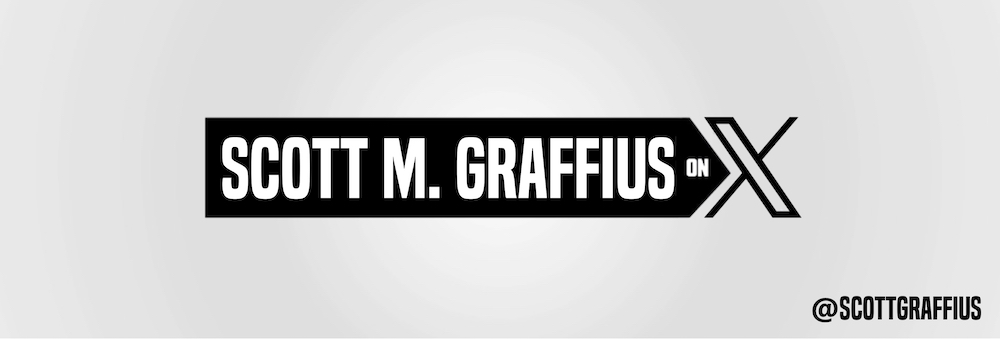

About Agile Scrum: Your Quick Start Guide with Step-by-Step Instructions

Shifting customer needs are common in today's marketplace. Businesses must be adaptive and responsive to change while delivering an exceptional customer experience to be competitive.
There are a variety of frameworks supporting the development of products and services, and most approaches fall into one of two broad categories: traditional or agile. Traditional practices such as waterfall engage sequential development, while agile involves iterative and incremental deliverables. Organizations are increasingly embracing agile to manage projects, and best meet their business needs of rapid response to change, fast delivery speed, and more.
With clear and easy to follow step-by-step instructions, Scott M. Graffius's award-winning Agile Scrum: Your Quick Start Guide with Step-by-Step Instructions helps the reader:
- Implement and use the most popular agile framework―Scrum;
- Deliver products in short cycles with rapid adaptation to change, fast time-to-market, and continuous improvement; and
- Support innovation and drive competitive advantage.
Hailed by Literary Titan as “the book highlights the versatility of Scrum beautifully.”
Winner of 17 first place awards.
Agile Scrum: Your Quick Start Guide with Step-by-Step Instructions is available in paperback and ebook/Kindle worldwide. Some links by country follow.
- 🇦🇺 Australia
- 🇦🇹 Austria
- 🇧🇪 Belgium
- 🇧🇷 Brazil
- 🇨🇦 Canada
- 🇨🇿 Czech Republic
- 🇩🇰 Denmark
- 🇫🇮 Finland
- 🇫🇷 France
- 🇩🇪 Germany
- 🇬🇷 Greece
- 🇭🇺 Hungary
- 🇮🇳 India
- 🇮🇪 Ireland
- 🇮🇱 Israel
- 🇮🇹 Italy
- 🇯🇵 Japan
- 🇱🇺 Luxembourg
- 🇲🇽 Mexico
- 🇳🇱 Netherlands
- 🇳🇿 New Zealand
- 🇳🇴 Norway
- 🇪🇸 Spain
- 🇸🇪 Sweden
- 🇨🇭 Switzerland
- 🇦🇪 UAE
- 🇬🇧 United Kingdom
- 🇺🇸 United States
- 🌏 More countries

About Agile Transformation: A Brief Story of How an Entertainment Company Developed New Capabilities and Unlocked Business Agility to Thrive in an Era of Rapid Change

Thriving in today's marketplace frequently depends on making a transformation to become more agile. Those successful in the transition enjoy faster delivery speed and ROI, higher satisfaction, continuous improvement, and additional benefits.
Based on actual events, Agile Transformation: A Brief Story of How an Entertainment Company Developed New Capabilities and Unlocked Business Agility to Thrive in an Era of Rapid Change provides a quick (60-90 minute) read about a successful agile transformation at a multinational entertainment and media company, told from the author's perspective as an agile coach.
The award-winning book by Scott M. Graffius is available in paperback and ebook/Kindle worldwide. Some links by country follow.
- 🇦🇺 Australia
- 🇦🇹 Austria
- 🇧🇷 Brazil
- 🇨🇦 Canada
- 🇨🇿 Czech Republic
- 🇩🇰 Denmark
- 🇫🇮 Finland
- 🇫🇷 France
- 🇩🇪 Germany
- 🇬🇷 Greece
- 🇮🇳 India
- 🇮🇪 Ireland
- 🇯🇵 Japan
- 🇱🇺 Luxembourg
- 🇲🇽 Mexico
- 🇳🇱 Netherlands
- 🇳🇿 New Zealand
- 🇪🇸 Spain
- 🇸🇪 Sweden
- 🇨🇭 Switzerland
- 🇦🇪 United Arab Emirates
- 🇬🇧 United Kingdom
- 🇺🇸 United States
- 🌏 More countries

Let's Connect

Connect with AgileScrumGuide.com on:
And connect with agile project management practitioner, consultant, award-winning author, and international speaker Scott M. Graffius on:

The short link for this article is: https://bit.ly/tac-24
© Copyright 2024 Scott M. Graffius, AgileScrumGuide.com. All rights reserved. This material may not be published, broadcast, rewritten or redistributed without the express written permission of Scott M. Graffius/AgileScrumGuide.com.

The Agile Coach: 2025 Edition



Introduction
The demand for Agile—and Agile expertise—is soaring in today’s dynamic business environment. To set the stage, here are insights on the driving forces behind Agile adoption and its most widely used framework, Scrum:
"Thriving in today’s marketplace frequently depends on making a transformation to become more Agile." — Scott M. Graffius, Agile Transformation: A Brief Story of How an Entertainment Company Developed New Capabilities and Unlocked Business Agility to Thrive in an Era of Rapid Change
"Shifting customer needs are common in today's marketplace. Businesses must be adaptive and responsive to change while delivering an exceptional customer experience to be competitive. Traditional development and delivery frameworks such as waterfall are often ineffective. In contrast, Scrum is a value-driven agile approach that incorporates adjustments based on regular and repeated customer and stakeholder feedback. Scrum’s built-in rapid response to change leads to substantial benefits such as fast time-to-market, higher satisfaction, and continuous improvement—which supports innovation and drives competitive advantage." — Scott M. Graffius, Agile Scrum: Your Quick Start Guide with Step-by-Step Instructions
As businesses increasingly recognize the benefits of Agile, more are embracing it to adapt, innovate, and thrive. However, while adopting Agile offers tremendous potential, the process is typically challenging. This is where the Agile Coach comes in. Agile Coaches play a critical role in ensuring successful Agile adoption, improvement, and sustained growth. Research underscores their value: Agile Coaches significantly enhance the likelihood of success in Agile transformations and advancements (Dikert, Paasivaara & Lassenius, 2016; Sureshchandra & Shrinivasavadhani, 2008).
Some might describe the Agile Coach role simply as "an individual who coaches agile teams." While accurate, such a definition is circular and limiting. A more comprehensive understanding of the role reveals the full breadth and depth of its impact:
"The individual is an agile expert who provides guidance for new agile implementations as well as existing agile teams. The Agile Coach is experienced in employing agile techniques in different environments and has successfully run diverse agile projects. The individual builds and maintains relationships with everyone involved, coaches individuals, trains groups, and facilitates interactive workshops. The Agile Coach is typically from outside the organization, and the role may be temporary or permanent." — Scott M. Graffius, Agile Transformation: A Brief Story of How an Entertainment Company Developed New Capabilities and Unlocked Business Agility to Thrive in an Era of Rapid Change
To further illuminate the role, Scott M. Graffius introduced 'The Agile Coach'—a visual model that encapsulates the values, guiding principles, focus areas, tools, and activities that define the position. First developed in 2019 and updated regularly, the 2025 edition of this visual appears at the top of this article.
This article will delve deeper into the Agile Coach role, providing examples, strategies, and actionable insights to support those aspiring to or working as Agile Coaches—and the organizations that benefit from their expertise.

The Agile Coach Infographic
In 2019, Scott M. Graffius first developed The Agile Coach as a high-level visual on the role. He periodically updates his respective work. The top of this article shows the 2025 edition. The visual highlights the values, guiding principles, focus areas, tools, and activities for Agile Coaches.
- Values include respect, courage, focus, openness, and commitment.
- Principles include collaboration, technical excellence, transparency, continuous improvement, simplicity, fast and frequent delivery, and high satisfaction.
- Focus areas include company; division or segment; product or service; tribe, squad, or team; and individuals.
- Tools include data collection, visualization, best techniques, feedback, and agile process tools.
- Activities include coaching, teaching, facilitating, and mentoring.
Values, Guiding Principles, Focus Areas, Tools, and Activities for Agile Coaches
This section elaborates on the values, guiding principles, focus areas, tools, and activities for Agile Coaches.
Values. Agile Coaches instill the core values that underpin Agile success. These include:
- Respect: Valuing diverse perspectives and contributions.
- Courage: The ability to speak up, challenge the status quo, and do the right thing.
- Focus: Maintaining a clear vision and prioritizing work that delivers the most value.
- Openness: Candid about the work and its challenges.
- Commitment: Dedication to the team/department/company and its goals.
Principles. Guided by the values, the principles include:
- Collaboration: Working together towards shared objectives.
- Technical excellence: Delivering high-quality work that is maintainable and scalable.
- Transparency: Fostering open communication and information sharing.
- Continuous improvement: A commitment and practice to constantly learn and evolve.
- Simplicity: Doing the least amount of work needed to achieve the objective or outcome.
- Fast and frequent delivery: Agile’s iterative and short-cycle incremental approach results in the rapid and frequent delivery of working products and services.
- High satisfaction: Delivering product and service features and functionality that offer value to the customer/user fosters and supports their satisfaction as well as the satisfaction of those doing the work.
Focus. Agile Coaches ensure a balanced focus across the organization. This may cover the company, division/segment, product/service, tribe/squad/team, and/or individuals to help the organization transform their processes and achieve its mission and strategic objectives. Examples follow.
- Company-wide strategy alignment: Agile Coaches ensure that team initiatives are aligned with broader company goals and objectives. They help bridge the gap between individual teams and the larger organization, fostering a unified approach to achieving business objectives.
- Division/segment/departmental performance: Agile principles can be applied across different departments within an organization. Agile Coaches can help technology and non-technology areas adopt Agile practices, leading to increased efficiency and improved collaboration across the company.
- The product or service itself: Understanding the product vision, roadmap, and user needs is crucial. Agile Coaches help teams prioritize features, delineate work into manageable user stories/requirements, and ensure the product delivers value to the customer.
- Tribe/squad/team dynamics: Building strong, self-organizing teams is essential for Agile success. Agile Coaches help foster collaboration, communication, and psychological safety within groups (which may be called tribes, squads, or teams), encouraging them to work effectively towards shared goals.
- Growth of individuals: Agile Coaches support the professional development of individuals. This could involve providing coaching on specific skills, identifying training opportunities, and encouraging knowledge sharing within the team.
Tools. Agile Coaches equip others with the tools — including data collection, visualization, best techniques, feedback, and agile process tools — needed to prosper in Agile environments. Examples follow.
- Data Collection and Analysis: Data-driven decision-making is crucial. Agile Coaches encourage teams to collect data on various metrics, such as velocity, cycle time, and defect rates. They then help teams analyze this data to identify areas for improvement and continuously refine their Agile practices.
- Visualization tools: Kanban boards, burndown charts, information radiators, and other visual tools provide beneficial views on the status of work.
- Best Techniques: There's a vast array of Agile techniques. Agile Coaches help teams select the most appropriate techniques for their specific context. This could involve introducing techniques like pair programming, test-driven development, or user story mapping.
- Feedback: Agile Coaches emphasize the importance of regular constructive feedback. They encourage team members to provide feedback to each other, as well as actively seek feedback from stakeholders throughout the development process.
- Agile process: Agile Coaches are skilled facilitators who can help with Agile processes such as Agile events/ceremonies. Examples include Sprint Planning, Daily Stand-Up Meetings, Sprint Review, and the Sprint Retrospective.
Activities. Activities are covered individually. In practice, however, they may overlap. Examples of activities — coaching, teaching, facilitating, and mentoring — follow.
- Coaching: Partnering with others in a process that helps them develop personally and professionally. This typically involves leveraging a wide array of knowledge and skills (such as technical expertise, business/product development/innovation expertise, organizational development/change management expertise, and more).
- Teaching: Instructing others in specific knowledge and skills.
- Facilitating: Guiding others through processes to help them arrive at solutions and formulate decisions.
- Mentoring: Sharing knowledge and skills with others to foster their personal and professional growth.
The Agile Coach as a Change Agent
Additionally, Agile Coaches serve as catalysts for cultural transformation within organizations. They help bridge the gap between traditional structures and the collaborative, fast-paced environment that Agile fosters. Agile Coaches usually achieve this through multiple means such as:
- Facilitating Open Communication: Agile practices rely on open communication and information sharing across all levels of the organization. Agile Coaches encourage open dialogue, helping to break down silos and fostering a culture of transparency.
- Empowering Teams: Agile Coaches empower teams to make decisions, take ownership of their work, and hold themselves accountable for results. This supports the development of effective self-organizing/self-managing teams.
- Managing Resistance to Change: Transitioning to Agile can be challenging. Agile Coaches serve as change agents, helping to manage resistance through clear communication, addressing concerns, and highlighting the benefits of Agile adoption.
- Building a Culture of Continuous Improvement: Agile Coaches instill a culture of continuous improvement. It involves encouraging experimentation, the practice of inspect and learn, and more.


Conclusion
For organizations seeking to adopt Agile or elevate their existing practices, an Agile Coach can be a transformative asset. With their deep expertise and strategic guidance, Agile Coaches unlock the full potential of Agile, driving exceptional outcomes that align with business goals.
What sets Agile Coaches apart is their ability to adapt to the unique needs of each organization. Whether it's coaching teams, aligning stakeholders, or fostering a culture of continuous improvement, they are skilled professionals who bring clarity, focus, and momentum to Agile transformations.
By investing in an Agile Coach, organizations are not just adopting a framework—they are investing in a future of innovation, collaboration, and sustained success. The results? Agile done right, empowered teams, and a competitive edge in today’s fast-paced world.
Read on for:
- References/sources,
- How to cite this article,
- Permission request information,
- About Scott M. Graffius,
- About Agile Scrum,
- About Agile Transformation,
- and more.


References/Sources
- Adkins, Lyssa (2010). Coaching Agile Teams: A Companion for ScrumMasters, Agile Coaches, and Project Managers in Transition. Upper Saddle River, New Jersey: Addison-Wesley Professional.
- Agile Alliance (2022, March). Code of Ethical Conduct for Agile Coaching (Version 2.0). Available at: https://www.agilealliance.org/agile-coaching-code-of-ethical-conduct/.
- CFO South Africa (2021, August 19). Agile Leadership Unlocked [Video]. Available at: https://www.youtube.com/watch?v=FJZiitw5tHo&t=359s.
- Dikert, K.; Paasivaara, M.; and Lassenius, C. (2016). Challenges and Success Factors for Large-Scale Agile Transformations: A Systematic Literature Review. Journal of Systems and Software, 119: 87-108.
- Exceptional Agility (2023, April 13). Scott M. Graffius Presenting "The Science of High-Performance Teams" at DevOps Institute Conference. Available at: https://exceptionalagility.com/blog/files/doi-conf.html.
- Ganesh, N.; and Thangasamy, S. (2012). Lessons Learned in Transforming from Traditional to Agile Development. Journal of Computer Science, 8 (3): 389-392.
- Graffius, Scott M. (2016). Agile Scrum: Your Quick Start Guide with Step-by-Step Instructions. North Charleston, SC: CreateSpace.
- Graffius, Scott M. (2018, October 18). Agile Scrum Helps Innovators, Disruptors, and Entrepreneurs Develop and Deliver Products at Astounding Speed Which Drives Competitive Advantage [Presentation]. Talk delivered at Techstars Startup Week Conference. DOI: 10.13140/RG.2.2.25009.12647.
- Graffius, Scott M. (2019). Agile Transformation: A Brief Story of How an Entertainment Company Developed New Capabilities and Unlocked Business Agility to Thrive in an Era of Rapid Change. Scotts Valley, CA: CreateSpace.
- Graffius, Scott M. (2020). Definition of Agile Culture. Available at: https://www.scottgraffius.com/blog/files/agile-culture.html. DOI: 10.13140/RG.2.2.11170.35521.
- Graffius, Scott M. (2021, February 20). But First, the Team! [Presentation]. Talk delivered at the Brno, Czech Republic DevConf.CZ 2021 Conference. DOI: 10.13140/RG.2.2.29016.72964.
- Graffius, Scott M. (2021, June 21). DevOps and Team Leadership [Workshop]. Session at private event in Las Vegas, NV. DOI: 10.13140/RG.2.2.15380.22401.
- Graffius, Scott M. (2021, May 13). But First, the Team! [Presentation]. Lecture delivered at DevOps Pro Europe 2021 Conference. Based and simulcast live from Vilnius, Lithuania. DOI: 10.13140/RG.2.2.30524.36481.
- Graffius, Scott M. (2021, November 8). Bruce Tuckman’s Model (Forming, Storming, Norming, Performing, and Adjourning) is Highly Relevant and Beneficial, But It Doesn’t Please Everyone. Available at: https://scottgraffius.com/blog/files/jobs.html.
- Graffius, Scott M. (2021, October 5). Navigate the Phases of Team Development with Speed and Agility for Happier and More Productive Teams [Presentation]. Talk delivered at the Institute of Electrical and Electronics Engineers IEEE Day 2021 Conference. DOI: 10.13140/RG.2.2.20055.19365.
- Graffius, Scott M. (2021). Phases of Team Development. Los Angeles, CA: Scott M. Graffius. DOI: 10.13140/RG.2.2.22040.42246.
- Graffius, Scott M. (2022, February 4). Team Development Tradecraft: A Source of Competitive Advantage [Workshop]. Session at private event in Adelaide, Australia. DOI: 10.13140/RG.2.2.14092.80002.
- Graffius, Scott M. (2022, May 13). Want Happier and More Productive DevOps Teams? [Presentation]. Talk delivered at DevOpsDays Geneva, Switzerland 2022 Conference. DOI: 10.13140/RG.2.2.22252.85127.
- Graffius, Scott M. (2023, April 26). The Science of High-Performance Teams [Presentation]. Talk delivered at the DevOps Institute’s SKILup Day 2023 Conference. DOI: 10.13140/RG.2.2.15888.28169.
- Graffius, Scott M. (2023, July 15). Successful Video Game Development Teams Leverage an Extensive Range of Hard Skills and Soft Skills. Available at: https://scottgraffius.com/blog/files/gamedev.html. DOI: 10.13140/RG.2.2.31205.17124.
- Graffius, Scott M. (2023, June 29). What Successful AI Teams Have in Common [Presentation]. Talk delivered at Conf42 Quantum Computing 2023 Conference. DOI: 10.13140/RG.2.2.29382.45120.
- Graffius, Scott M. (2023, May 1). Fueling the Development of Innovative and Life-Changing AI Solutions [Presentation]. Talk delivered to an audience of Technology professionals (including Data Scientists, Machine Learning Engineers, Data Engineers, AI Researchers, Project Managers, Business Analysts, UX Designers, Software Developers, Cloud Architects, Data Privacy and Security Specialists, and others involved or interested in AI) at a private event in Mountain View, California, United States. DOI: 10.13140/RG.2.2.27956.73601.
- Graffius, Scott M. (2023, October 13). The Science of High-Performance Game Development Teams [Presentation]. Talk delivered at the W Love Games International Video Game Development Conference 2023 - Helsinki, Finland. DOI: 10.13140/RG.2.2.28602.16326.
- Graffius, Scott M. (2023). The Agile Coach: An Infographic (2023 Edition). Available at: https://agilescrumguide.com/blog/files/the-agile-coach-2023.html.
- Graffius, Scott M. (2024, April 5). The Agile Coach: 2024 Edition. Available at: https://agilescrumguide.com/blog/files/tac-2024.html.
- Graffius, Scott M. (2024, January 8). Scott M. Graffius’ Phases of Team Development: 2024 Update. Available at: https://scottgraffius.com/blog/files/teams-2024.html. DOI: 10.13140/RG.2.2.28629.40168.
- Graffius, Scott M. (2024, May 21). What Successful AI Development Teams Have in Common. Talk at DevDays Europe 2024 Conference. DOI: 10.13140/RG.2.2.24313.07529.
- Graffius, Scott M. (2024, May 3). Leverage Agile and AI to Innovate at the Speed of Light. Talk at private event in Dubai, UAE. DOI: 10.13140/RG.2.2.30790.48960.
- Graffius, Scott M. (2024, November 18). Side-by-Side Comparison of Retrospectives and Hot Washes. Available at: https://scottgraffius.com/blog/files/retrospectives-and-hot-washes.html.
- Graffius, Scott M. (2025, January 7). Scott M. Graffius’ Phases of Team Development: 2025 Update. Available at: https://scottgraffius.com/blog/files/phases-of-team-development-update-for-2025.html. DOI: 10.13140/RG.2.2.33705.30564.
- Graffius, Scott M. (2025, January 23). Wild World of Team Dynamics: Forming, Storming, Norming, Performing and Adjourning | #Team #Teamwork. Video. Available at: https://www.youtube.com/watch?v=eE1HTarKqEw.
- Graffius, Scott M. (2025, January 24). When Agile, AI, and Strategic Thinking Converge. Available at: https://scottgraffius.com/blog/files/when-agile-ai-and-strategic-thinking-converge.html. DOI: 10.13140/RG.2.2.22277.46565.
- Kerzner, Harold (2022). Innovation Project Management: Methods, Case Studies, and Tools for Managing Innovation Projects (Second Edition). Hoboken, New Jersey: John Wiley & Sons, Inc.
- Meadows, Donella H. (2008). Thinking in Systems: A Primer. White River Junction, Vermont: Chelsea Green Publishing.
- Nelson, Ken; Ronka, David; Lang, Lesli; Korabek-Emerson, Liz; and White, Jim (2020). Designing & Leading Life-Changing Workshops: Creating the Conditions for Transformation in Your Groups, Trainings, and Retreats. Kittery Point, Maine: Cliffhouse Press.
- Paulise, Luciana (2021, September 29). Why An Agile Coach Can Help Your Team Overcome The Great Resignation. Forbes. Available at: https://www.forbes.com/sites/lucianapaulise/2021/09/29/why-an-agile-coach-can-help-your-team-overcome-the-great-resignation/.
- Scrum Alliance (n.d.). The Growing Impact of Agile Coaching: Notes from the Research Study on Agile Coaching from SINTEF. Available at: https://resources.scrumalliance.org/Article/growing-impact-agile-coaching.
- Stanier, Michael Bungay (2016). The Coaching Habit: Say Less, Ask More & Change the Way You Lead Forever. Vancouver, British Columbia, Canada: Page Two. Order your book today.
- Sureshchandra, K.; and Shrinivasavadhani, J. (2008). Moving from Waterfall to Agile. Proceedings from Agile, 2008: AGILE ’08 Conference. Toronto, Ontario, Canada.
- Thompson, S.; and Cox, E. (2017). How Coaching is Used and Understood by Project Managers in organizations. Project Management Journal, 48 (5): 64-77.


How to Cite This Article
Graffius, Scott M. (2025, January 27). The Agile Coach: 2025 Edition. Available at: https://agilescrumguide.com/blog/files/the-agile-coach-2025.html. DOI: 10.13140/RG.2.2.24282.86725


How to Request Permission
To request permission to use Scott M. Graffius' 'The Agile Coach' infographic, contact Scott M. Graffius.
If your request is approved, a high resolution version of the image will be provided along with applicable terms and conditions.

About Scott M. Graffius

Scott M. Graffius is a high impact and globally recognized AI, advanced technology, agile, and project management researcher, thought leader, author, and public speaker.
Graffius has generated more than USD $1.9 billion in business value for organizations served, including Fortune 500 companies. Businesses and industries range from technology (including R&D and AI) to entertainment, financial services, and healthcare, government, social media, and more.
Graffius leads the professional services firm Exceptional PPM and PMO Solutions, along with its subsidiary Exceptional Agility. These consultancies offer strategic and tactical advisory, training, embedded talent, and consulting services to public, private, and government sectors. They help organizations enhance their capabilities and results in agile, project management, program management, portfolio management, and PMO leadership, supporting innovation and driving competitive advantage. The consultancies confidently back services with a Delighted Client Guarantee™. Graffius is a former vice president of project management with a publicly traded provider of diverse consumer products and services over the Internet. Before that, he ran and supervised the delivery of projects and programs in public and private organizations with businesses ranging from e-commerce to advanced technology products and services, retail, manufacturing, entertainment, and more. He has experience with consumer, business, reseller, government, and international markets.
He is the author of two award-winning books.
- His first book, Agile Scrum: Your Quick Start Guide with Step-by-Step Instructions (ISBN-13: 9781533370242), received 17 awards.
- His second book is Agile Transformation: A Brief Story of How an Entertainment Company Developed New Capabilities and Unlocked Business Agility to Thrive in an Era of Rapid Change (ISBN-13: 9781072447962). BookAuthority named it one of the best Scrum books of all time.
Organizations around the world invite Graffius to speak on tech (including AI), agile, project management, program management, portfolio management, and PMO leadership. He has developed and delivered unique and compelling talks and workshops. To date, Graffius has delivered 91 sessions across 25 countries. Select examples of events include Agile Trends Gov, BSides (Newcastle Upon Tyne), Conf42 Quantum Computing, DevDays Europe, DevOps Institute, DevOpsDays (Geneva), Frug’Agile, IEEE, Microsoft, Scottish Summit, Scrum Alliance RSG (Nepal), Techstars, and W Love Games International Video Game Development Conference (Helsinki), and more. With an average rating of 4.81 (on a scale of 1-5), sessions are highly valued.
For booking inquiries, complete the speaker engagement request form or email directly to explore how Graffius can help elevate your organization’s performance.
Prominent businesses, professional associations, government agencies, and universities have featured Graffius and his work including content from his books, talks, workshops, and more. Select examples include:
- Adobe,
- American Management Association,
- Amsterdam Public Health Research Institute,
- Bayer,
- BMC Software,
- Boston University,
- Broadcom,
- Cisco,
- Coburg University of Applied Sciences and Arts Germany,
- Computer Weekly,
- Constructor University Germany,
- Data Governance Success,
- Deimos Aerospace,
- DevOps Institute,
- EU's European Commission,
- Ford Motor Company,
- GoDaddy,
- Harvard Medical School,
- Hasso Plattner Institute Germany,
- IEEE,
- Innovation Project Management,
- Johns Hopkins University,
- Journal of Neurosurgery,
- Lam Research (Semiconductors),
- Leadership Worthy,
- Life Sciences Trainers and Educators Network,
- London South Bank University,
- Microsoft,
- NASSCOM,
- National Academy of Sciences,
- New Zealand Government,
- Oracle,
- Pinterest Inc.,
- Project Management Institute,
- Mary Raum (Professor of National Security Affairs, United States Naval War College),
- SANS Institute,
- SBG Neumark Germany,
- Singapore Institute of Technology,
- Torrens University Australia,
- TBS Switzerland,
- Tufts University,
- UC San Diego,
- UK Sports Institute,
- University of Galway Ireland,
- US Department of Energy,
- US National Park Service,
- US Tennis Association,
- Veleučilište u Rijeci Croatia,
- Verizon,
- Virginia Tech,
- Warsaw University of Technology,
- Wrike,
- Yale University,
- and many others.
Graffius has been actively involved with the Project Management Institute (PMI) in the development of professional standards. He was a member of the team which produced the Practice Standard for Work Breakdown Structures—Second Edition. Graffius was a contributor and reviewer of A Guide to the Project Management Body of Knowledge—Sixth Edition, The Standard for Program Management—Fourth Edition, and The Practice Standard for Project Estimating—Second Edition. He was also a subject matter expert reviewer of content for the PMI’s Congress. Beyond the PMI, Graffius also served as a member of the review team for two of the Scrum Alliance’s Global Scrum Gatherings.
Graffius has a bachelor’s degree in psychology with a focus in Human Factors. He holds nine professional certifications:
- Certified SAFe 6 Agilist (SA),
- Certified Scrum Professional - ScrumMaster (CSP-SM),
- Certified Scrum Professional - Product Owner (CSP-PO),
- Certified ScrumMaster (CSM),
- Certified Scrum Product Owner (CSPO),
- Project Management Professional (PMP),
- Lean Six Sigma Green Belt (LSSGB), and
- IT Service Management Foundation (ITIL).
He is an active member of the Scrum Alliance, the Project Management Institute (PMI), and the Institute of Electrical and Electronics Engineers (IEEE).
He divides his time between Los Angeles and Paris, France.


About Agile Scrum: Your Quick Start Guide with Step-by-Step Instructions
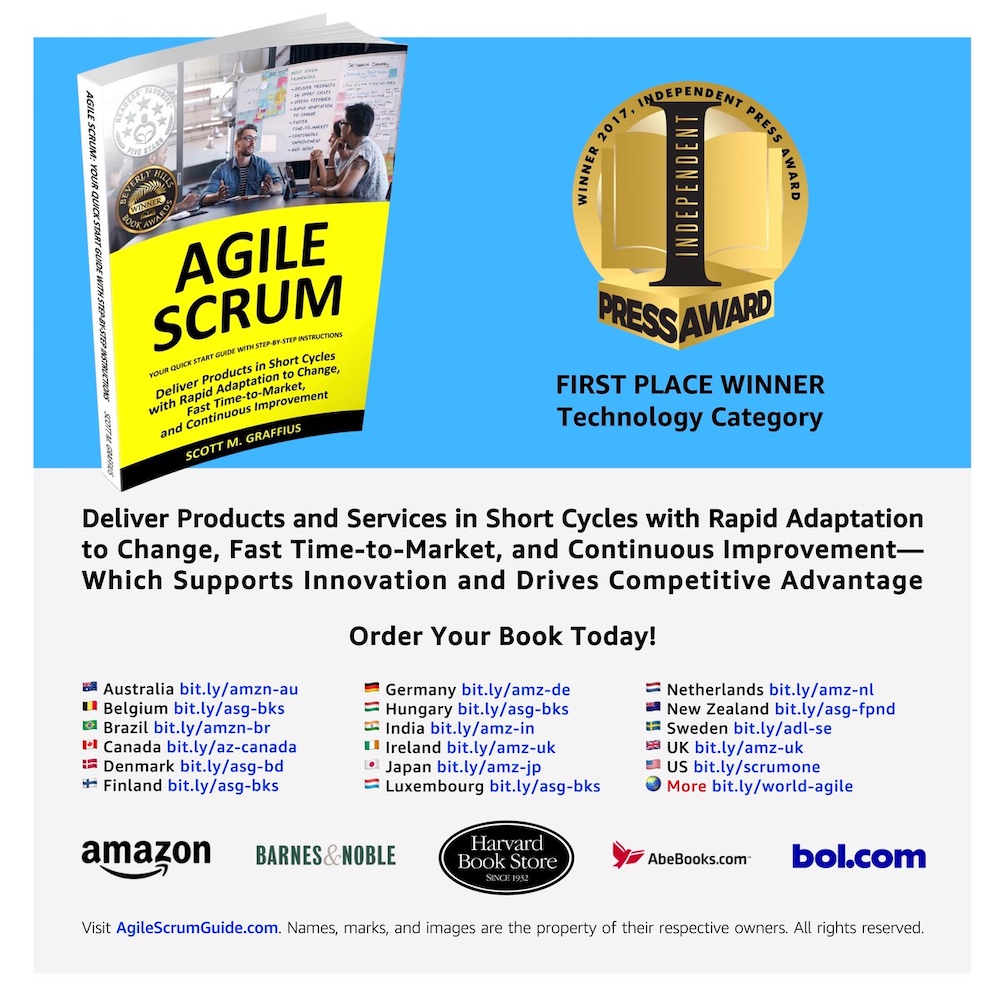
Shifting customer needs are common in today's marketplace. Businesses must be adaptive and responsive to change while delivering an exceptional customer experience to be competitive.
There are a variety of frameworks supporting the development of products and services, and most approaches fall into one of two broad categories: traditional or agile. Traditional practices such as waterfall engage sequential development, while agile involves iterative and incremental deliverables. Organizations are increasingly embracing agile to manage projects, and best meet their business needs of rapid response to change, fast delivery speed, and more.
With clear and easy to follow step-by-step instructions, Scott M. Graffius's award-winning Agile Scrum: Your Quick Start Guide with Step-by-Step Instructions helps the reader:
- Implement and use the most popular agile framework―Scrum;
- Deliver products in short cycles with rapid adaptation to change, fast time-to-market, and continuous improvement; and
- Support innovation and drive competitive advantage.
Hailed by Literary Titan as “the book highlights the versatility of Scrum beautifully.”
Winner of 17 first place awards.
Agile Scrum: Your Quick Start Guide with Step-by-Step Instructions is available in paperback and ebook/Kindle worldwide. Some links by country follow.
- 🇦🇺 Australia
- 🇦🇹 Austria
- 🇧🇪 Belgium
- 🇧🇷 Brazil
- 🇨🇦 Canada
- 🇨🇿 Czech Republic
- 🇩🇰 Denmark
- 🇫🇮 Finland
- 🇫🇷 France
- 🇩🇪 Germany
- 🇬🇷 Greece
- 🇭🇺 Hungary
- 🇮🇳 India
- 🇮🇪 Ireland
- 🇮🇱 Israel
- 🇮🇹 Italy
- 🇯🇵 Japan
- 🇱🇺 Luxembourg
- 🇲🇽 Mexico
- 🇳🇱 Netherlands
- 🇳🇿 New Zealand
- 🇳🇴 Norway
- 🇪🇸 Spain
- 🇸🇪 Sweden
- 🇨🇭 Switzerland
- 🇦🇪 UAE
- 🇬🇧 United Kingdom
- 🇺🇸 United States
- 🌏 More countries

About Agile Transformation: A Brief Story of How an Entertainment Company Developed New Capabilities and Unlocked Business Agility to Thrive in an Era of Rapid Change

Thriving in today's marketplace frequently depends on making a transformation to become more agile. Those successful in the transition enjoy faster delivery speed and ROI, higher satisfaction, continuous improvement, and additional benefits.
Based on actual events, Agile Transformation: A Brief Story of How an Entertainment Company Developed New Capabilities and Unlocked Business Agility to Thrive in an Era of Rapid Change provides a quick (60-90 minute) read about a successful agile transformation at a multinational entertainment and media company, told from the author's perspective as an agile coach.
The award-winning book by Scott M. Graffius is available in paperback and ebook/Kindle worldwide. Some links by country follow.
- 🇦🇺 Australia
- 🇦🇹 Austria
- 🇧🇷 Brazil
- 🇨🇦 Canada
- 🇨🇿 Czech Republic
- 🇩🇰 Denmark
- 🇫🇮 Finland
- 🇫🇷 France
- 🇩🇪 Germany
- 🇬🇷 Greece
- 🇮🇳 India
- 🇮🇪 Ireland
- 🇯🇵 Japan
- 🇱🇺 Luxembourg
- 🇲🇽 Mexico
- 🇳🇱 Netherlands
- 🇳🇿 New Zealand
- 🇪🇸 Spain
- 🇸🇪 Sweden
- 🇨🇭 Switzerland
- 🇦🇪 United Arab Emirates
- 🇬🇧 United Kingdom
- 🇺🇸 United States
- 🌏 More countries


Digital Object Identifier (DOI)
DOI: 10.13140/RG.2.2.24282.86725


Short Link
The short link for this article is https://bit.ly/coach-2025


Copyright © Scott M. Graffius
Copyright © Scott M. Graffius. All rights reserved.
Content on this site—including text, images, videos, and data—may not be used for training or input into any artificial intelligence, machine learning, or automatized learning systems, or published, broadcast, rewritten, or redistributed without the express written permission of Scott M. Graffius.
